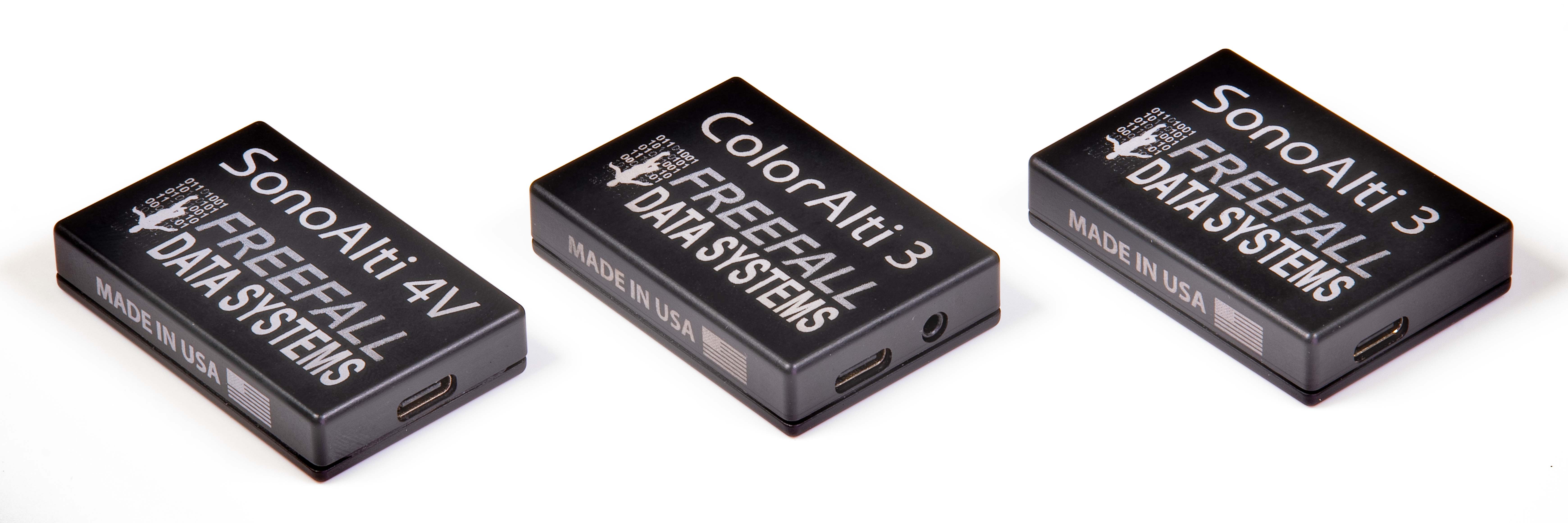Comparing FDS Audibles
FDS currently manufactures three different audible altimeters with contrasting purposes and capabilities. SonoAlti 3 is our standard audible altimeter that emits beeps and sirens. ColorAlti 3 (US Patent No. 10,267,630 B2) has all of the capabilities of SonoAlti 3 with the addition of being able to connect a light of the user’s choice via a 2.5 mm port. Both of these altimeters are highly customizable via BLE and the FDS Altis app with up to five presets. Both are data-logging altimeters that can be used with FDS Logbook. They have long a battery life of up to five months. SonoAlti 4V is a speaking audible. In contrast to the other two altimeters, it is set using a web app in a browser. SonoAlti 4V has two presets that cannot be changed; these can be used for just about any jumps (Standard Default Setting and Low-Speed Default Setting for wingsuiting). It then features three User Presets that make it the most highly customizable speaking audible in the industry. You can even add your own sounds. SonoAlti 4V can get up to eight weeks of battery life. It is, however, not a logging device and does not interface with FDS Logbook.

While all three of these devices can be used on just about any type of skydive, what we recommend depends on several different factors, the first which is simply the type of helmet being used. While speaking audibles have become very popular, very loud helmets—or helmets where the audible pockets do not line up well with the ear canal (e.g. the Kiss helmet)—are less suitable for speaking audibles. The next factor might be the types of jumps one does. Those who do a lot of jumps where it isn’t ideal to look at a wrist-mounted altimeter (tracking, freeflying, wingsuiting, camera flying, etc.) can benefit in particular from the constant input afforded by ColorAlti 3 and SonoAlti 4V. For the highest-speed disciplines, we tend to favor ColorAlti 3 over SonoAlti 4V, as audibles become more difficult to hear with increasing wind noise. For those who are hard of hearing, we always recommend ColorAlti® technology. These are only recommendations, however, and we are always glad to discuss individual cases if you call us up or send us an e-mail.
Altitude Indication Technologies
The main advantage of the beeping audible is that it is the most jarring of all of the possible altitude alerts, particularly in freefall. This is due to psychoacoustic characteristics of the alarms they put out. They are generally meant to function much like a fire alarm near breakoff time, pull altitude, or decision altitude. The main disadvantage of these is the fact that you tend to wait for them to sound—jumpers do not typically pay attention to them until around breakoff and lower.
Our patented ColorAlti® technology has the potential to seal the gaps, so-to-speak, in a skydiver’s altitude awareness. In contrast to other technologies, it makes it possible to have truly constant, granular input of altitude in real-time through light in peripheral vision. We are not waiting to hear the audible call something out or emit a siren; rather the input is continually there in our peripheral vision. This being said, a beeping audible is more likely to grab one’s attention at breakoff. We thought: Why not combine both in one device? And ColorAlti 3 was born, offering the best of both worlds.
The speaking audible is a newer technology, growing fast in popularity. This is understandable, as there is not much better for the development of altitude awareness than having the altitude actually called out for you both on the way up as well as on the way down at regular intervals. This teaches you to associate an altitude picture with a number and in many cases, it practically replaces your wrist-mounted altimeter. It can also tell you things like "pull” or "seatbelts.” The primary disadvantage is that they are not as loud or attention-getting as a beeping audible. This is why we gave SonoAlti 4V the ability to beep as well, although the beeps and sirens it can emit are not quite as loud as those of beeping audibles like ColorAlti 3 and SonoAlti 3, which use a different speaker technology.
Comparison Chart
SonoAlti 3
ColorAlti 3
SonoAlti 4V
Release Date
June 18, 2025
June 18, 2025
August 7, 2024
Price
$319
$389
$389
Dimensions
51 x 35 x 12 mm
51 x 35 x 12 mm
53 × 33 × 11 mm
Volume
21.4 cm3
21.4 cm3
19.2 cm3
Weight
28.8 g
33.1 g
31.2 g
Case Material
6061 aluminum
6061 aluminum
6061 aluminum
Speaker Driver Technology
piezoelectric
piezoelectric
dynamic
Operating Altitude
0–30,000 ft
0–30,000 ft
0–30,000 ft
Battery Life
16 weeks
16 weeks
8 weeks
Warranty
2 years
2 years
2 years
Number of Possible Alarms
unlimited
unlimited
unlimited
Number of Different Sounds
32
32
100+
Number of Jumps One Can Log
500
500
none
Works With FDS Logbook
✅
✅
❌
Spoken Announcements/Notifications
❌
❌
✅
Add Your Own Sounds (WAV files)
❌
❌
✅
LED Visual Alerts and Effects
❌
✅
❌
Vertical Descent Speed Tracking
❌
❌
✅
Presets Selectable on Device Itself
✅
✅
✅
Integrated Real-Time Clock/Calendar
✅
✅
❌
Low Battery Warning
✅
✅
✅
Adjustable Loudness
✅
✅
✅
Wingsuit/Swoop Modes
✅
✅
✅
LZ Elevation Offset Possible
✅
✅
✅
Rechargeable
✅
✅
✅
Always On
✅
✅
✅
iOS/Android Bluetooth App
✅
✅
WebUSB app